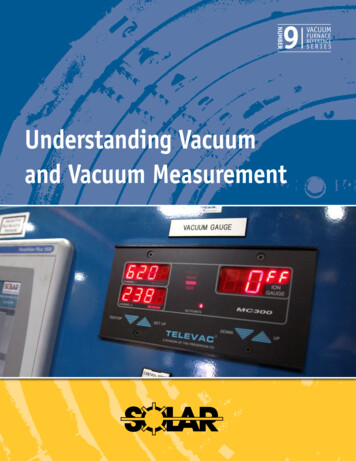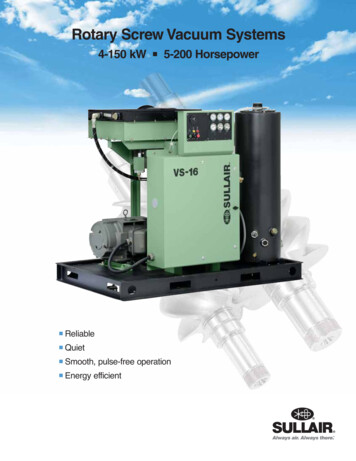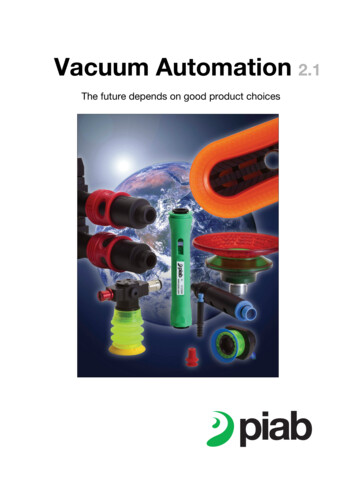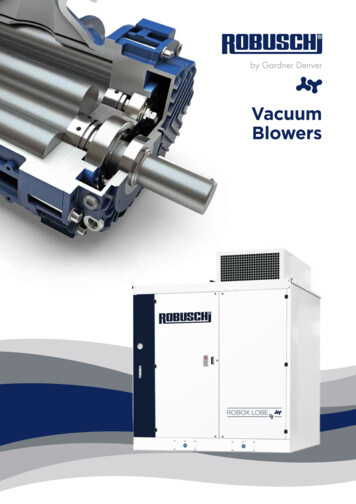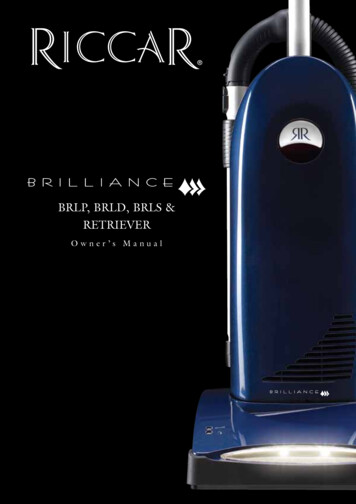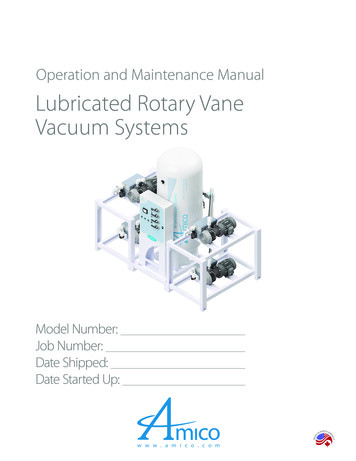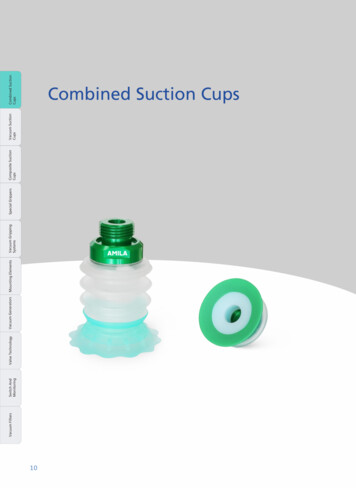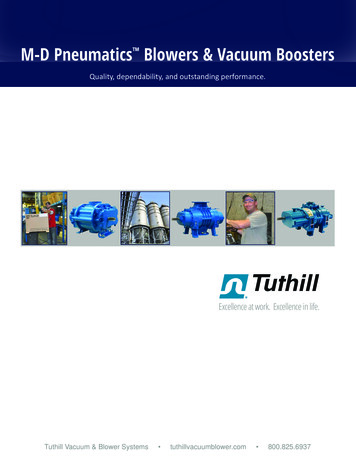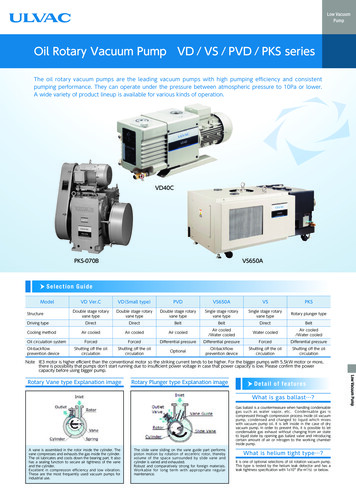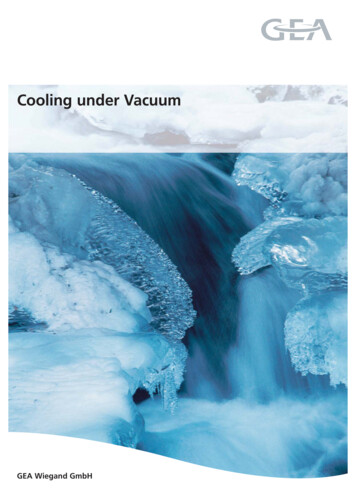
Transcription
Cooling under VacuumGEA Wiegand GmbH
Table of ContentsIntroductionIntroduction2Comparison between compression cooling plantsand steam jet cooling plants2Steam Jet Cooling Plants – Construction Detailsand How They Work3Advantages of flash cooling plants3Vapour compression using jet pumps4Flash cooling4Steam Jet Cooling Plants – Types5Steam jet cooling plants of compact design5Steam jet cooling plants of column design6Steam jet cooling plants of bridge design7Standardised steam jet cooling plants – sizes8Installation and Control10Possible combinations10Installation alternatives11Control of steam jet cooling plants12Heat Recovery Plants14Criteria for the Designof Steam Jet Cooling PlantsCooling is an expensive process. Ongoing increases inenergy costs demand alternatives to traditional systems(mechanical compressors). More and more, flash coolingplants offer an environmentally friendly and economicalsolution.GEA Wiegand has more than fifty years of experience inthe design and construction of flash cooling plants.GEA Wiegand reference plants:wateraqueous nitric acid/phosphoric acidaqueous plaster suspensioncalcium milkbarium hydroxide solutionsvarious waste watersfruit juicemilkglueThe steam jet cooling plants may have a capacity betweenapproximately 10 and 20 000 kilowatts. As an example,water may be cooled down to a temperature of approximately 5 C.15Comparison between compression cooling plants and steam jet cooling plantsType of cooling plantCoolingprocessheat transferequipmentVapour CompressionprocessequipmentMotive power of the compressorCompression cooling plantSteam jet cooling t or indirectflash vesselmechanicalscrew, turbo or piston compressorfluid dynamicjet pump (vapour compressor)electrical energy (motor)Discharge of heat energyprocessheat rmal energy (motive steam)condensationdirect or indirectcondenser
Steam Jet Cooling Plants – Construction Detailsand How They WorkB41Fig. 1: Diagram of a steam jet coolingplant with mixing condenser212345CA3A flash vesselB steam jet compressorC mixing condenser5Advantages of flash cooling plantssimple and robust constructionreliable and safe to usevery little wear and tear owing to no moving partsminimal maintenancedirect and indirect cooling is possible; with indirectcooling, the cooling medium is almost always waterand therefore easy to handlemotive steammedium to be cooledchilled mediumcooling waterwarmed cooling watervery low chilled-medium hold-up volumefrequent or fast change of load possibleminimum electrical energy requiredwaste heat and flash steam used as the motive mediaused very efficiently during seasonal and/or batchoperationcoefficient of performance* value may be furtherimproved by employing a motive steam saving control* Coefficient of Performance chilling capacity divided by motive powerClassification of flash cooling plantsCooling plantsHeat recoveryGenerating low temperaturesTemperature of the chilled medium 1Temperature of the cooling water at inletTemperature of the chilled mediumTemperature of cooling water at inletNatural pressure head,No compression required 1Compression required(Vacuum) cooling plantRe-cooling plantSteam jet cooling plantHeat recoveryby thermocompressione.g. waste water coolinge.g. cooling tower쑺 page 5쑺 page 143
Steam Jet Cooling Plants – Construction Details and How They WorkVapour compression using jet pumpsJet pumps are compressors driven by a fluid and haveno moving parts: the vapour, flashed from the suctionmedium (i. e. the medium to be cooled) passes throughthe suction nozzle, into the head of the jet pump.The motive medium (usually steam) is expanded, afterpassing through a motive nozzle, where the pressureenergy is transformed into kinetic energy. This energystream impinges with and conveys the suction medium(i. e. the medium to be cooled), accelerating it into theinlet cone of the mixing nozzle. After passing throughthe throat of the mixing nozzle, into the diffusor, thekinetic energy of the mixed vapour stream is graduallyconverted back into potential energy, i. e. the medium iscompressed to a higher discharge pressure (fig. 2).Flash coolingFor each type of fluid the evaporation pressure requiresa particular evaporation temperature. A liquid will startto boil if it is subjected to a pressure that is lower than itsevaporation pressure. The correlation for water within atemperature range of between 0 C and 100 C is shownin the diagram (fig. 3). In flash cooling plants, only asmall proportion of the medium to be cooled is evaporated (vapour flow [kg/s]). The thermal energy requiredfor this process is taken from the remaining medium: itstemperature drops until the boiling temperature to thelower pressure has been reached.The vapour flow conveys the thermal energy from thecooled medium into a condenser thereby transferringthe thermal energy to another system (heat consumer,re-cooling system etc.).4Fig. 2: Construction of a jet pump and variation of pressure12345head chambermotive nozzleinlet conethroatoutlet cone冧diffusor,mixing nozzlep1p0ppsΔpv·M1·M0·Mmotive steam pressuresuction pressuredischarge pressurepressure at sonic speedcompression impactmotive steam flowsuction flowmixed-vapour flowFig. 3: Saturation curve (water) : ts f(ps)Fig. 4: 100 kg/s water at 20 C are cooled down to 10 C by evaporationof 1.66 kg/s of water resulting in 98.34 kg/s water at the outlet.A pressure of approx. 1.23 kPa (abs.) must be maintained in thischamber. The evaporation enthalpy is 2 478 kJ/kg resulting in a chillingcapacity of 2478 kJ/kg x 1.66 kg/s 4 113 kW.
Steam Jet Cooling Plants – TypesBasically, there are three different types of steam jet cooling plants:compact design for small capacities;column design for medium capacity and large capacities where there is little floor area;bridge design for high capacities.Steam jet cooling plants of compact designThese consist of horizontally designed equipment: oneflash vessel (1) and one condenser stage (2) being installed in a common horizontal vessel. The jet pump (3)is arranged in parallel to this vessel. A small liquid ringvacuum pump (4) is installed as a deaeration unit. Thecondensation heat is removed via the cooling water – e.g.by a cooling tower (6). The plant is controlled by anoperation control system.This type of design requires relatively little floor space andnot too much height.Fig. 5: 2-stage steam jet cooling plant of compact design, cooling 44 m3/hr ofwater from 30 to 10 C.Fig. 63cooling watermotive steammedium to be cooledflash vesselcondenserjet pumpdeaeration vacuumpump5 collection tank6 re-cooling plant7 circulation pumps12344125567775
Steam Jet Cooling Plants – TypesSteam jet cooling plants of column designThese are of vertical construction: flash cooling chamber(1) and condenser chamber (2) are mounted one on topof the other. The flash vessels and the condenser chambers of each stage are connected to each other throughpiping or a jet pump for vapour compression (3). In manycases, a cooling tower (6) is installed in order to re-coolthe cooling water. Generally, a steam jet vacuum pumpis provided as a deaeration unit. The plant is controlledby an operation control system.This type of design requires a relatively small floor space,but greater height.Fig. 7: 2-stage steam jet cooling plant of column design,cooling 200 m3/hr of water from 10 to 5 C.Chilling capacity: 1163 kWFig. 8cooling watermotive steammedium to be cooled42flash vesselcondenserjet pumpsdeaeration vacuumpump5 collection tank6 re-cooling plant7 circulation pumps1234313676577
Steam Jet Cooling Plants – TypesSteam jet cooling plants of bridge designThese consist of vertically or horizontally arranged flashcooling chambers (1), horizontally mounted jet pumps(3) and vertically designed condenser chambers (2). Theflash vessel and condenser chambers of each stage areconnected by piping or a jet pump for vapour compression (3). In many cases, a cooling tower (6) is includedfor re-cooling of the cooling water. A steam jet vacuumpump for deaeration is also included. The plant is controlled by an operation control system.This type of design requires relatively little height but morefloor space.Fig. 9: 3-stage steam jet cooling plant of bridge design,cooling 194 m3/hr of water from 28 to 15 C.Chilling capacity: 2 900 kWFig. 10cooling watermotive steammedium to be cooledflash vesselcondenserjet pumpsdeaeration vacuumpump5 collection tank6 re-cooling plant7 circulation pumps123443123131657777
Steam Jet Cooling Plants – TypesStandardised steam jet cooling plants – sizesGEA Wiegand offers standardised plants.Advantages:simple designlow investment costsshorter delivery timesEight standardised sizes are available for particular applications (table). Tailor-made design is available on request.The given dimensions refer to the pictures on the right/next page (fig. 11, fig. 12 and fig. 13).Net chilling capacitykW201003006001 0003 0007 50015 000Medium to be cooled (water)inlet temperatureoutlet temperaturevolume flownozzle sizes: inlet/outlet C 0/200126145150/250126435250/4001261 086400/7001262 172600/1 000Cooling waterinlet temperatureoutlet temperaturevolume flow C Cm3/h304030403040304030403040304030402 140600/1 0004 275900/1 400nozzle sizes: 250/350855400/600Motive steam (0.4 MPa (abs.))summer (100 % load)spring/summer1) 60 %winter1) 20 %kg/hkg/h95appr. 60440appr. 2601 100appr. 6602 150appr. 1 3003 450appr. 2 0709 450appr. 5 70023 50047 000appr. 14 000 appr. 28 000kg/happr. 20appr. 90appr. 200appr. 430appr. 700appr. 1 900appr. 4 700appr. 9 actcolumncolumncolumnMake-up water demand (e.g. 12 C)m /hNumber of stagesType of designcompactInstallationnon-barom.non-barom. non-barom.2) non-barom.2) rometricElectrical powerliquid ring pump vacuum pumpcooling water pump 13) (100 %)cooling water pump 23) (100 %)chilled media pump 3) (100 %)cooling tower fan (100 718(without)6204502802561 606Dimensions (steam jet cooling 12.02.52.514.0331715513 4)207221320 4)30 4)Weights5)emptyoperatingfilled with 51002401502005501) Central Europe2) plus supply tank for cooling medium discharge3) with reference to /- 0.0 m4) plus barometric height (11 m)5) without platforms, pumps, cooling tower and piping8
Steam Jet Cooling Plants – TypesFig. 11: Column designFig. 12: Bridge designFig. 13: Compact design9
Installation and ControlPossible combinationsCooling plants usually consist of three components:cooling plant itselfcirculation of the chilled mediumcirculation of the cooling waterMost of the flash cooling plants are operated under vacuum. The chilled medium and/or the cooling water mustthen be conveyed from that vacuum and fed into therelevant circulation process.A barometric arrangement allows a particularly simpledischarge from the vacuum. If however, a minimum 11 mheight for this arrangement is not available, than nonbarometric installation is required (page 11).The table shows numerous possible combinations ofdesign and installation: a cooling plant may have a barometric or a non-barometric discharge, each with threedesign alternatives for the circulation of the chilled medium as well as for the cooling water circulation. Thetable below illustrates this.Possible combinations of design and installationThe cooling plant as a2-stage steam jet cooling plant incompact designcolumn designbridge design5112The essential types of installation for thedischarge of the chilled medium, fromvacuumbarometricnon-barometric5451242 2 222 2 233Circulation of the chilled mediumdirectdirect, via a storage tankindirect, via intermediate heat transferto/from requirement of the cooled-media.The essential types of installation for thedischarge of cooling water, from vacuumbarometricnon-barometric1113334 4 44 4 466Cooling water circulationdirect via a cooling towerindirect, via intermediate heat transferto the cooling towerindirect, via intermediate heat transferto other heat absorbers(river water, other processes .)104555666
Installation and ControlInstallation alternativesInstallation may be barometric or non-barometric:Fig. 15: Non-barometric Installation 11 m 11 mFig. 14: Barometric installationcooling watermotive steamAdvantages:The suction pressure of the circulation pump is alwayshigher than or equal to atmospheric pressure, thereforehardly any risk of cavitation.The vacuum chamber is only separated from atmospheric pressure by liquid column in the barometric leg.Usually this system cannot considered as pressurevessel because this arrangement does not allow thebuild up of over-pressure.Note:The installation height of the vacuum chambers mustbe at least 11 m above the seal water pot.Advantages:The difference in height between the vacuum chambersand the seal water pot may be less than 11 m.Note:The suction pressure of the circulation pump is belowatmospheric pressure, therefore, the circulation pumpmust be protected against cavitation.Because of the closed construction, the vessels willusually be considered as pressure vessels which maybe subject to special requirements in design and manufacture.11
Installation and ControlControl of steam jet cooling plantsSteam jet cooling plants are controlledin order to match the chilling capacity to the relevantdemand and/orto reduce operating costs.Fig. 16: Maximum temperatures of the re-cooled water over oneyear (central Europe)Capacity controlThe capacity of a steam jet cooling plant can be alteredby turning on/off the motive steam valves of the individual jet pumps. Assuming a constant flow of the mediumto be cooled, the chilling capacity can be controlled inaccordance with the temperature of the chilled mediumat the outlet of the steam jet cooling plant. This can bemade either manually or by automatic control.Control of the motive steam flow – motive steam saving controlSteam jet cooling plants are designed for the least favourable operating conditions which may occur, e.g. for thehighest annual cooling water temperature.The diagram (fig. 16) shows a typical temperature profile over a period of one year in central Europe. Given aconstant cooling water flow, the condensation pressureis markedly below the value of the process design duringmost of the year. Accordingly, the vapour compressormay compress against a lower pressure than the processdesign value.Corresponding to the characteristics of jet pumps, themaximum allowable discharge pressure at the outlet ofthe jet pump is proportional to its motive steam pressurewithin a certain range. The maximum allowable discharge pressure must always be at least as high as thecondensation pressure in the downstream condenser.If the temperature of the cooling water drops, the condensation pressure will drop correspondingly. Then the jetpump need not compress to the high process designdischarge pressure and the motive steam pressure can becorrespondingly reduced by means of a throttle valve.Thus, the motive steam consumption of the steam jetcooling plant is reduced while keeping the chilling capacity unchanged. The diagrams (fig. 17 and 18) illustratethis relationship.This saving of motive steam contributes to improvingthe average annual COP* value.* Coefficient of Performance chilling capacity divided by motive power12Fig. 17: Steam consumption depending on the cooling water temperaturein a four stage plant (valid for cooling to 10 ºC)Fig. 18: Steam consumption profilebased on the ratios shown in the two diagrams (fig. 16 and 17).Average steam consumption 72 % of the maximum value
Installation and ControlSteam and cooling water requirement of steam jet coolingplantsThe steam and cooling water requirement of steam jetcooling plants depends onthe medium to be cooledthe cooling water temperaturethe motive steam pressurethe number of stages of the plant andthe required chilled medium temperature at the outletof the plantFig. 19 shows the motive steam and cooling water consumption. As an example, 100 m3/hr of water are cooledfrom 20 to 10 C with a two-stage steam jet cooling plant.From the diagram of fig. 19, a cooling water demand ofapprox. 200 m3/hr (for heating of cooling water from24 to 35 C) and a motive steam consumption of approx.1 800 kg/hr (7 bar (g)/170 C) can be obtained. Furthermore, it shows that more stages reduce the operatingcosts, but increase the investment costs (and vice versa).Fig. 19: Steam and cooling water requirement of continuouslyoperated steam jet cooling plants with mixing condensationn number of flash stagestKaWa chilled medium outlettemperature [ C]Q chilling capacity [kW]Optimum steam and cooling water requirement in steamjet cooling plantsThe chilling factor R helps to calculate which level ofcooling water heating can lead to low operating costs.chilling factor R K ·steam price/tcooling water price/m3The value K refers to the average steam consumption inper cent. As an example, a relatively high steam priceresults in a big value R. As a consequence, a small coolingwater temperature rise will save operating costs, andvice versa (see fig. 20). In the diagram, K 0.7 (70 % ofthe process design value) is for cooling of 100 m3/hr ofwater from 20 to 5 C, corresponding to a chilling capacity of 1 745 kW in a three-stage steam jet cooling plantwith mixing condensation.It is based on these conditionsThe cooling water flow remains constant.The steam flow is controlled.Fig. 20: Optimising the operating costs13
Heat Recovery PlantsMany processes discharge water or an aqueous liquidwith a relatively high temperature. In this case, heatrecovery plants may reducethe operating costs andpollution through better use of energy.In principle, GEA Wiegand’s heat recovery process isvery similar to the flash cooling process, see page 4.However, the heat recovery process aims at a re-utilisation of the heat energy. The flashed/evaporated vapouris compressed to a higher pressure by a jet pump ( thermocompressor) in order to reclaim the heat energy at ahigher temperature level.Fig. 21: Chemical industryFig. 22: Paper industry3412321cooling watermotive steammedium to be evaporateddrying cylindercollecting tankflash vesseljet pump (thermocompressor)1 evaporator2 jet pump (thermocompressor)3 condenser1234In an evaporator, vapour is generated at 200 kPa abs. and 60 C. A largeportion of the vapour can be re-utilised by a jet pump for heating. In thepresent example, and compared to heating with fresh steam, approximately60 % of the fresh steam mass flow can be saved by re-utilising the vapour(assumption: fresh steam: 0.3 MPa (g)).Heat is drawn by means of flash evaporation from the warm condensatecoming from the drying cylinders of a paper machine. It is compressed by ajet pump to the higher heating steam pressure level. In this case, the jetpumps are designed for a variable flow (nozzle needle control) in order to correspond to the very precise control requirements of the paper industry.14
Criteria for the Design of Steam Jet Cooling PlantsDespite standardisation, steam jet cooling plants are usually tailor-made plants. Due to the various applicationpossibilities and the very individual requirements of the operators, their size, construction, arrangement and modeof operation are very different.These questions should be answered first:1. What shall be cooled/chilled?Fluid characteristics such as boiling point elevation, crystal precipitation, etc.?2. How much shall be cooled/chilled?Mass flow or volume flow; in batches or continuously?3. Cooling range?Inlet and outlet temperature?Time period, in case of batch operation?4. Driving Energy?Which motive steam pressure levels are available? How much does thesteam cost? Which mass flows are available (may waste steam or flashsteam be taken into consideration)?5. Method of cooling?What type and quantity of cooling medium is available and at what cost?6. How warm is the cooling medium?What is the minimum and maximum temperature for the coolingmedium during the operation process?7. Type of installation?Barometric or non-barometric?8. Type of condensation?Direct (condensate and cooling medium are mixed) or indirect (condensate and cooling medium are not mixed)?9. Required chilling capacity?10. Type of material of construction?What kind of load profile is expected (full load, partial load)?The type of operating medium, the place of erection, (climate etc.) alongwith the experience of the operators may require particular materials ofconstruction.11. Are there any further regulationsAre there any legal regulations or works standards that must be takeninto account?12. Special requests?Has any particular experience been gained from the operation of similarplants, or are there any special requirements in relation to the steam jetcooling plant?13. Notes:15
Condensation plantswith surface or mixing condensers, to condense vapour and steam/gasmixtures under vacuum.Vacuum/steam jet cooling plantsto produce cold water, cool liquids, even of aggressive and abrasivenature.Jet pumpsto convey and mix gases, liquids, and granular solids; for direct heatingof liquids; as heat pumps; and in special design for the most diversefields of application.Overview on our Rangeof ProductsSteam jet vacuum pumpsalso product vapour driven; also in combination with mechanicalvacuum pumps (hybrid systems); extensive application in thechemical, pharmaceutical and food industries, in oil refineries and forsteel degassing.Evaporation plantsto concentrate any type of fluid food, process water, organic andinorganic solutions and industrial waste water; with additional equipment for heating, cooling, degassing, crystallization and rectification.Heat recovery plantsto utilize residual heat from exhaust gases, steam/air mixtures,condensate and product.Distillation / rectification plantsto separate multi-component mixtures, to recover organic solvents;to clean, recover and dehydrate bio-alcohol of different qualities.Alcohol production linesfor potable alcohol and dehydrated alcohol of absolute purity;integrated stillage processing systems.Vacuum degassing plantsto remove dissolved gases from water and other liquids.Heating and cooling plantsmobile and stationary plants for the operation of hot water heatedreactors, contact driers.Gas scubbersto clean and dedust exhaust air, separate aerosols, cool and conditiongases, condensate vapours and absorb gaseous pollutants.Project studies, engineering for our plants.Process EngineeringGEA Wiegand GmbHEinsteinstrasse 9-15, 76275 Ettlingen, GermanyTel. 49 7243 705-0, Fax 49 7243 705-330E-Mail: info.gewi.de@geagroup.com, Internet: www.gea-wiegand.comP106E 022009 / Hinkel & Junghans, Werbeagentur, KAMembrane filtration – GEA Filtrationto concentrate and process fluid food, process water and industrialwaste water, to separate contaminations in order to improve qualityand recover valuable substances.
(Vacuum) cooling plant Re-cooling plant Steam jet cooling plant Heat recovery by thermocompression . cooling tower fan (100 %) kW 0.5 2.0 6 11 18 52 128 256 total kW 2.7 8.2 27 50 91 292 718 1606 Dimensions (steam jet cooling plant) length m 2.5 3.5 2.0 2.5 3 15 20 22 4) 1 2 2.
